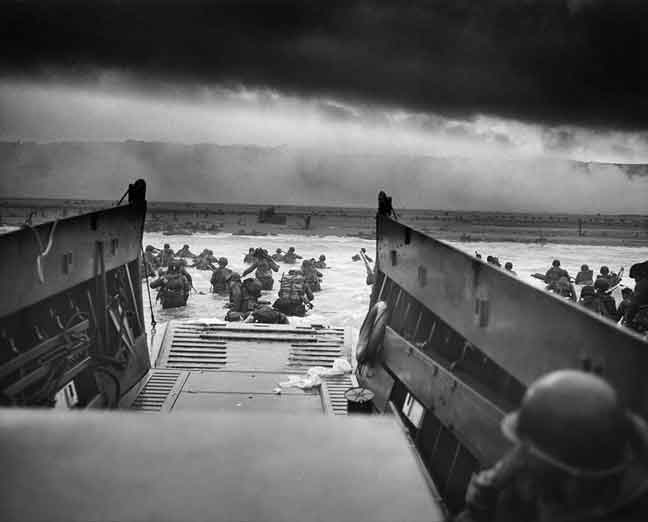June 4,1944 D-Day Invasion of Normandy

Omaha Beach
The invasion began with a massive naval bombardment. The U.S. First Army began landing on the Omaha and Utah beaches, while the British Second Army landed on Gold Juno and Sword beaches. Americans soldiers had a hard time making it off the beachhead at Omaha beach. Eventually their very large numbers, and the close naval support they received from U.S. Destroyers turned the tide of battle. As a result, they managed to move inland. America lost about 2,500 soldiers on the beaches of Normandy, but the Allies were back in France to stay.The planning for D-Day began in 1943. The Russians had been asking from 1942 for the Allies to open a second front against the Nazis, but the initial answer was the invasion of North Africa. The British were opposed to landing in France too early and urged delay. Finally May 1944 was set as the date for the attack. The invasion was assigned the name Operation Overlord. For almost a year a steady stream of men and material were transported to England prepare for the invasion. Thirty-nine allied divisions; 22 American, 12 British, 3 Canadian and one Polish and French prepared for the invasion. As part of the plans the Allies set up fake armies to keep the Germans guessing as to where the invasion would take place. With no port close by the Germans were not expecting Normandy to be the location for the invasion.
Because of a lack of landing craft the invasion was delay from May until June. The invasion was set for June 5th but bad weather forced the invasion to be delayed for one day. In the month before the invasion Allied air forces bombed targets throughout France to try make it difficult for the German to reinforce their forces.
The invasion forces included 6,939 ships, 1213 warships, 4,126 landing craft, 736 support ships and 864 merchant ships. At midnight 2,2000 British, Canadian and American planes started attacking targets around the coast and inland. As part of the operations airborne troops were landed behind the lines, who were tasked with either capturing or destroying key bridges and junctions. Many of the airborne troops missed their targets when landing, but the failure of some of the troops to land in the right locations, confused the Germans who were unsure where the main assault was coming. An earlier destruction of the German radar station allowed the fleet to remain undetected until 2 AM.
The invasion was divided into a number of different locations. One was Utah beach. There the 4th Infantry landed 2000 yards south of their intended target due to a strong current. The mistaken location turned out to be a good location. Because they landed to the south they did not achieve their first day objectives, but by nightfall they had landed 21,000 troops and sustained only 179 casualties.
The most heavily defended beach was Omaha Beach and there the troops had a hard time landing. When they first did land they were often pinned down by the German troops . Many of the tanks landing craft never made it to beach. Slowly the overwhelming number of allied troops with strong support from naval ships offshore allowed the American troops of the 1st and 29th Infantry Divisions slowly move off the beach and conquer the heights above. Casualties that first day at Omaha were 2,000 troops and it took until the third day of invasion for the goals of D-day to all be achieved at Omaha Beach
The invasion on at Gold Beach began a little later due to the difference in tides. The shore included fortified houses, but they were quickly cleared by troops of the British 30th Division. There was also heavy gun emplacement located at near the beach, three of which were knocked out by direct naval gunfire the fourth by charges placed at the rear of one of the emplacement. By the end of the day both the beach and the heights above were in British hands.
The British X corps were responsible for capturing the Sword Beach, Most of their amphibious
tanks made it to the beach, thus providing cover for the infantry. The beach was covered with obstacles that slowed the advance, but slowly the troops who were soon joined by French troops cleared the beach. In the course of the day the troops who captured Sword beach suffered 1,000 casualties.
All together the Allies had 10,000 casualties on D-Day with 4,414 confirmed dead. However, in the course of the first day 160,000 Allied troops landed. While none of the objectives of the first day were achieved , by the end of June and additional 800,000 men with all their equipment were landed and their was no stopping the better equipped Allied troops, the Germans could only hope to slow them down.
 >
>